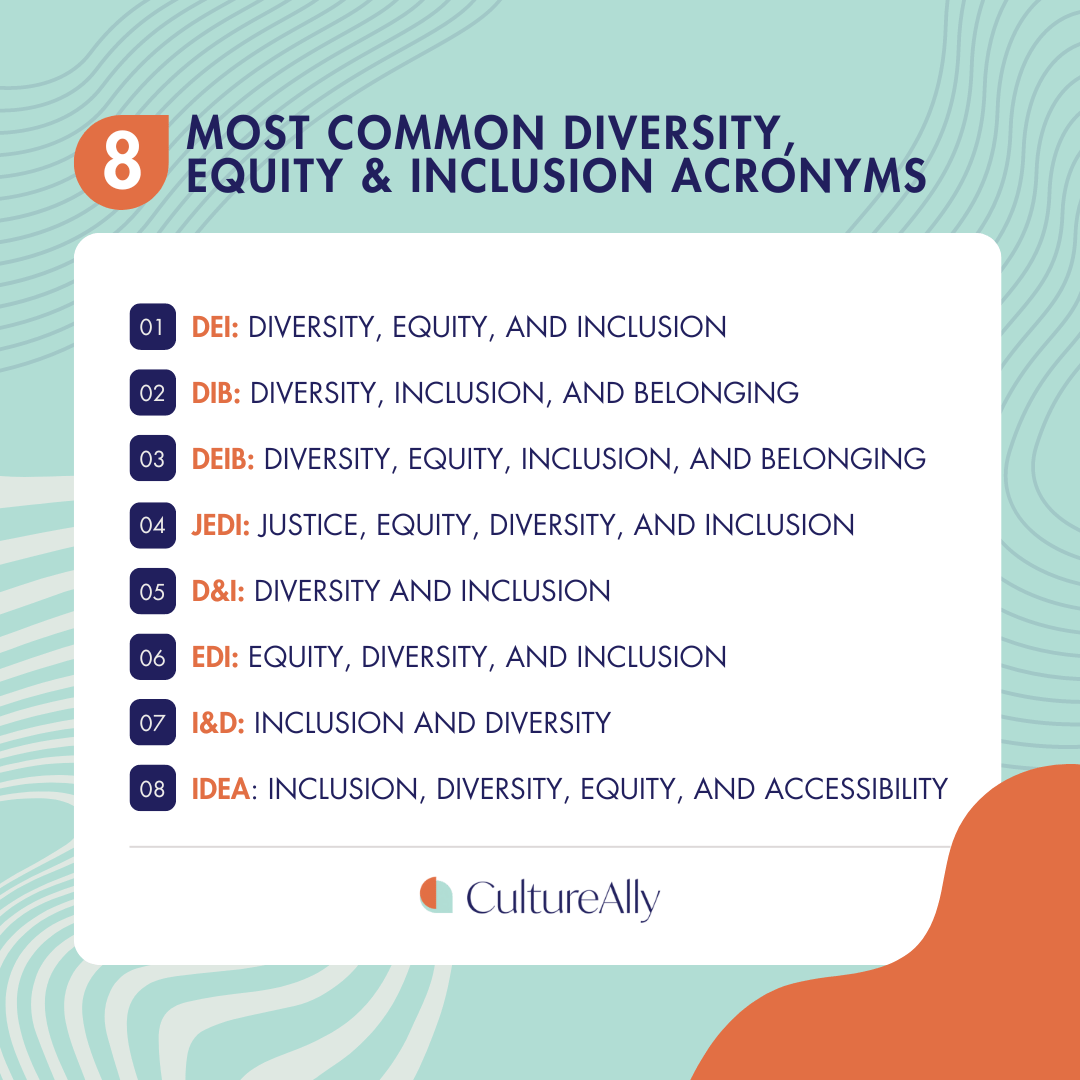A Practical Guide to DEI Acronyms
The world of diversity training has changed drastically since the cringe-worthy episode from The Office. People are now more attuned to the importance of diversity, equity and inclusion in the workplace.
And with DEI becoming commonplace at work, more DEI terminology is being utilized to describe the different challenges and goals that we all aspire to!
Overview of the DEI Acronym Building Blocks
Diversity
Refers to the presence of differences within a given setting, encompassing various characteristics such as race, gender, age, sexual orientation, disability, and more. It highlights the value of having a range of perspectives and experiences to enrich a community or organization.
Equity
Involves ensuring fair treatment, opportunities, and outcomes for all individuals by addressing and removing systemic barriers. It focuses on creating conditions that enable everyone to succeed, recognizing that different people may need different resources and support to achieve similar outcomes.
Inclusion
The practice of creating environments where all individuals feel welcomed, respected, and valued. It involves actively engaging and integrating diverse individuals into all aspects of an organization or community, ensuring they can fully participate and contribute.
Justice
Refers to the pursuit of fair and just treatment for all individuals, often by addressing and rectifying historical and current inequalities and injustices. It involves creating systems and policies that uphold fairness, protect rights, and ensure equitable opportunities for all.
Belonging
The feeling of being accepted, included, and valued within a group or community. It goes beyond inclusion by fostering a sense of connection and shared identity, where individuals feel they are an integral part of the whole.
Accessibility
The concept that every individual, regardless of their abilities or circumstances, can reach and utilize resources in various environments. This requires eliminating physical, technological, and systemic obstacles to foster equal participation and inclusion for all.
The History of DEI Acronyms
The focus on diversity and inclusion began to gain traction in the 1960s and 1970s, particularly in the United States, with the civil rights movement and subsequent affirmative action policies. Organizations began to recognize the importance of having diverse workforces and creating inclusive environments.
By the late 1990s and early 2000s, the focus expanded to include equity. This shift recognized that simply having diverse representation was not enough. It was also crucial to address systemic barriers such as pay gaps and promotion disparities to ensure fair treatment and opportunities for all.
In the 2010s, the concept of belonging started gaining prominence. Researchers and practitioners recognized that feeling a sense of belonging was essential for individuals to fully engage and contribute to their environments.
The term of justice emerged more recently, in response to growing awareness of social justice issues and the need for systemic change. The increased visibility of movements such as Black Lives Matter played a significant role in this shift.
In addition, accessibility is now increasingly being added as organizations focus on the importance of ensuring that everyone has equitable access to opportunities, resources, and information. The focus on accessibility recognizes that barriers to access can prevent true inclusion and equity, whether they are physical or invisible disabilities (IE people with mobility challenges or others with ADHD)
8 Common Diversity, Equity, and Inclusion Acronyms
DEI: Diversity, Equity, and Inclusion
Diversity: The presence of differences within a given setting, including race, gender, age, sexual orientation, disability, and other attributes.
Equity: Ensuring fair treatment, opportunities, and advancement while striving to identify and eliminate barriers that have prevented the full participation of some groups.
Inclusion: Creating environments in which any individual or group can be and feel welcomed, respected, supported, and valued.
DIB: Diversity, Inclusion, and Belonging
Belonging: The sense of being accepted, included, and valued by others in a given environment.
DEIB: Diversity, Equity, Inclusion, and Belonging
Combines the principles of DEI with the focus on fostering a sense of belonging.
JEDI: Justice, Equity, Diversity, and Inclusion
Justice: The pursuit of fair treatment and outcomes for all individuals, often focusing on rectifying past and current inequities.
D&I: Diversity and Inclusion
Focuses on promoting diversity and ensuring inclusive practices without explicitly emphasizing equity.
EDI: Equity, Diversity, and Inclusion
Similar to DEI, but places equity first to highlight its importance in addressing systemic barriers.
I&D: Inclusion and Diversity
Emphasizes the importance of creating inclusive environments as a foundation for diversity.
IDEA: Inclusion, Diversity, Equity, and Accessibility
Accessibility: Ensuring that individuals have equitable access to opportunities, resources, and information.
These acronyms represent various frameworks and approaches to creating more inclusive and equitable environments. They may be used interchangeably or in combination, depending on the specific focus and goals of an organization or initiative.
Map Your DEI Goals to Your Training Topics
Mapping Diversity, Equity, and Inclusion (DEI) goals to specific training initiatives is crucial because it ensures targeted development, making training programs more effective in addressing specific needs.
This alignment fosters accountability, ensuring everyone understands their role in achieving DEI objectives. Consistent messaging across the organization is achieved, improving engagement and commitment to an inclusive culture.
We have put together a list of trainings directly attributed to each “building block” of DEI:




